2011 Index of Reports
Report 1: January – February
Report 2: February – March
Report 3: March – April
Report 4: April – May
Report 5: May – June
Report 6: June – August
Report 7: August – October
Report 8: October – December
Field Report #1
Clay Plager-Unger
Planet Drum Foundation
January-February 3, 2011
Welcome to 2011. This year we are starting off with more trees in the greenhouse than ever before. The rainy season commenced in late December and after a slow start appears to have really gotten going now with regular rains and sprinkles during many of the nights. The days are hot, humid and sunny, perfect for the plants.





The volunteer situation has improved dramatically since the second half of 2010. There are currently 3 volunteers in house, with more slated for arrival in the coming weeks. Additionally, there have been a handful of others who have come to lend a hand on a more or less regular basis, depending on their situation. We are happy to have the help, since as always, there’s tons of work to be done. Everyday there are between four and seven people heading out to do some revegetation work.




We have been prepping and planting more sites. There are currently four revegetation sites underway and we are working on acquiring more. The revegetation site behind the greenhouse is completed with over 500 trees and the Dr. Parra site nearby continues to expand as we make more trails, dig more holes, plant more trees and finally mark them with bamboo stakes.


Each of these steps is time consuming and incredibly demanding work. Fortunately we have a highly motivated crew right now who bring a great positive attitude. Trails can take days to make throughout a multiple hectare site. Hundreds of holes must be dug, work that can be painfully slow when overnight rains make the soil muddy and incredible sticky. Trees must be transported to the sites and from there up hills to where they will be planted.
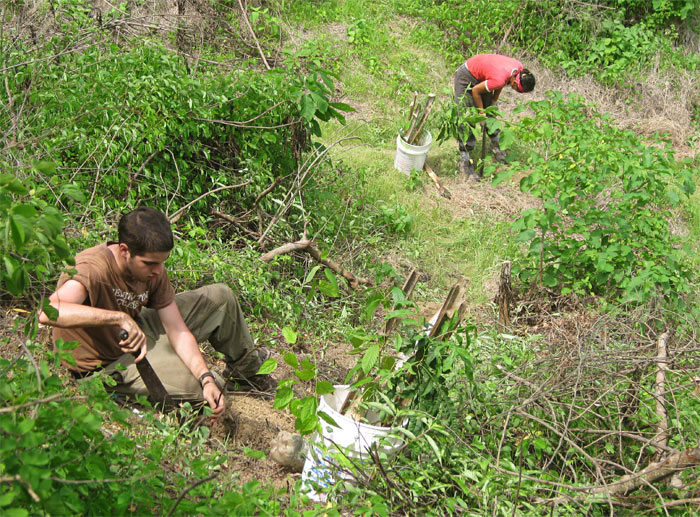
Orlando ingeniously came up with the idea to use recycled paint buckets for carrying trees. Each bucket perfectly holds 4 trees, which is about how much one person can manage to carry, especially if the trail is steep. Armed with a bucket of trees, a machete and a knife for cutting the trees out of the plastic bottles, the volunteers penetrate the dry-tropical brush, restoring this highly damaged ecosystem by carefully planting one native tree at a time.


The light rains have also been great for weeds and we’ve had to be vigilant as to not lose track of the trees that have already been planted. Vines are the biggest threat to a small tree since they can grow multiple inches per day and once wrapped around a tree will seriously stunt its growth.
The greenhouse has also been kept in spectacular shape and there are well over 4,000 trees from last year to be planted this rainy season. The rains caused several hundred more seeds to germinate in the seeds beds that we thought had already been emptied. Jaboncillo, Bototillo, Algarrobo and Guachepeli trees were all transplanted and the beds turned for future planting. The greenhouse has been kept tidy and we have received several groups to show off our native tree vegetation project.
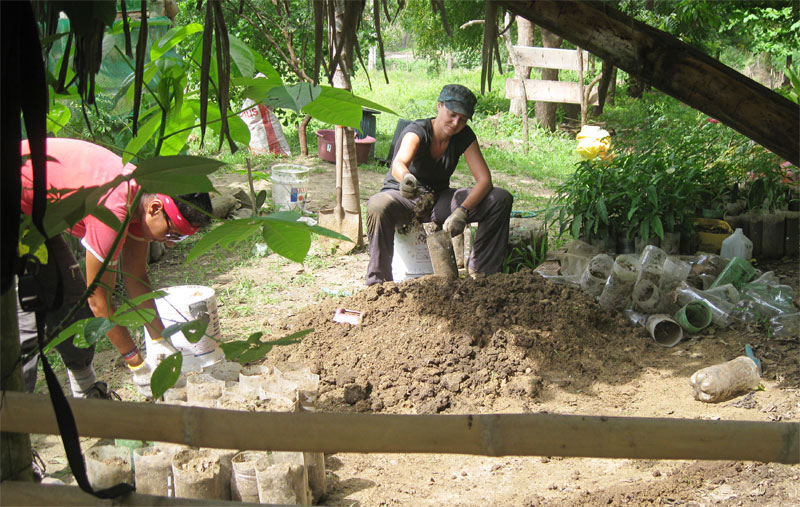



Keeping the weeds back consumes a lot of our time. The compost pile has grown with all the organic scraps we’ve been collecting and production coming out of the end of the trench has been excellent in quality.

The social networking aspect of our mission has also increased during 2011. Many people and organizations have been writing to collaborate by sending volunteers or in other ways. Current volunteers have been actively recruiting others and spreading the message. Additionally, we have made plans with an ex-volunteer, Jasper Oshun, who now runs an organization of his own, to donate trees to be planted by national and international volunteers at the Punta Gorda Reserva, which is run by Planet Drum Bioregionalismo coordinator and teacher Ramon Cedeño.

Their group will receive between 500 and 1,000 trees from the Planet Drum greenhouse for their tree planting trip at La Gorda in March and April. In exchange, they will help organize local volunteers (under the coordination of ex-Bioregionalismo class assistant and Bioregionalista extraoridinaire Raisa Torres) to help produce the same number of trees at the Planet Drum greenhouse for planting next year.
We received film-maker Karney Hatch to make a short about Planet Drum Ecuador and its projects. Karney stayed with us for 6 days, filming Bahia, volunteers, the work and all aspects of our projects. Keep an eye out in the coming weeks for the internet release.
In a final piece of news, Molly Thomas, the first Bioregional Sustainability Institute student, completed her 3-month stay in Bahia. Among revegetation, bioregional education and ancient culture studies, she completed a personal project which focused on water use in a neighboring community to Bahia, Bellavista. She conducted an extensive interview of water use among over 60 households. The data she collected will remain with Planet Drum and the community for use in future projects.

Molly managed to further unite an already tightly knit community and rallied residents to pursue a more equitable water distribution system, coupled with increased education about water conservation importance and sustainability issues. Each household received at least one native fruit-bearing tree from the Planet Drum greenhouse and through workshops with the community they were instructed how to plant and care for their trees. The most popular trees were Pechiche, Chirimoya and Guayaba. In total, over 140 trees were donated to the community. Thanks for your hard work and dedication, Molly, your work in Bellavista will have a lasting impact.
Pásalo bien,
Clay
Field Report #2
Clay Plager-Unger
Planet Drum Foundation
February-March 3, 2011



The past few weeks have been filled with lots of sun, hard work, and above all tons of tree planting. The Dr. Parra revegetation site has been completed and is the largest site to date with just over 700 native trees planted on a series of hills which wrap around his property. The amount of work that goes into an endeavor of this size is difficult to calculate, but just preparing the site requires trails (probably several kilometers worth), holes for all the trees, stakes to mark the trees, carrying trees to the holes and finally planting them. And this doesn’t take into consideration the time to produce each tree from seed to sapling, which involves collecting 3-liter bottles, preparing soil, filling the bottles, transplanting seedlings and then months of carrying for the baby trees as they grow—weeding and watering.

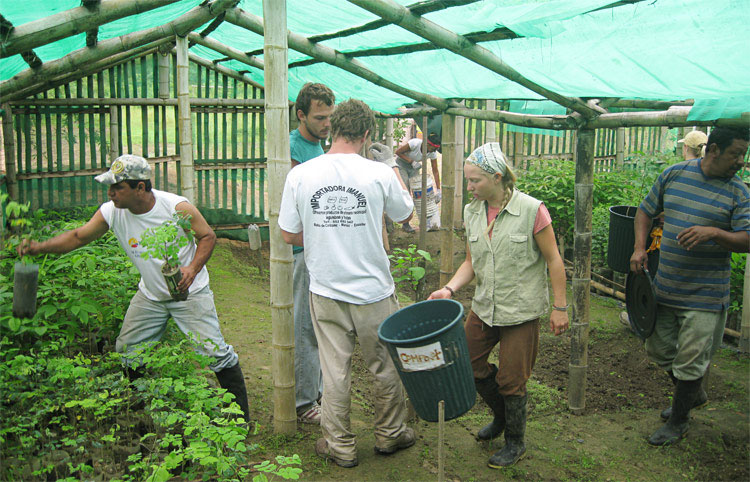



Fortunately we were graced with the presence of numerous volunteers who all pitched in over the course of the past month (and longer in some cases). Thanks to Ishrat, Guy, Sara, Amanda, Simon, Kate, Layne, Ramon, Roberto, Raisa, Pedro and Bernardo for pitching in to help us plant trees!
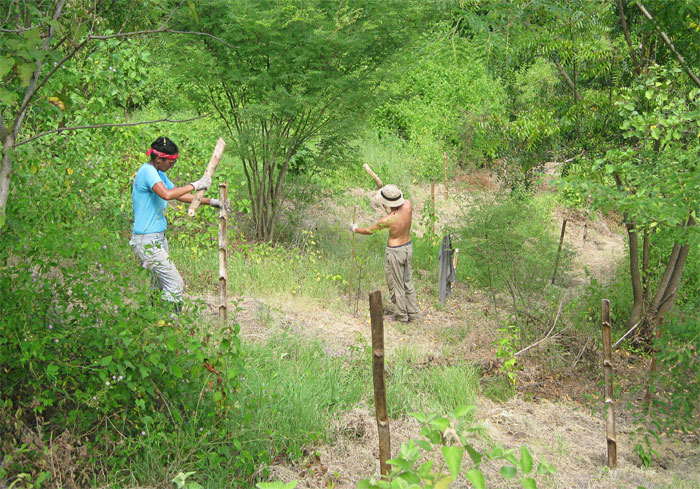


Aside from the usual field work, we also participated in the 12th anniversary Eco-city celebrations on February 22nd and 23rd. There was an open house where we gave out fruit trees to the public. Each individual could receive a plant for free. We arrived with a batch of 80 trees, unsure of how interested people would be in getting a tree to plant. Since we had fruit trees at the greenhouse, we focused on native fruit trees such as Chirimoya, Pechiche, and Guayaba. The first batch flew off the table and we had to send a truck to pick up another load, which also disappeared almost immediately. Hopefully the trees will be cared for. And Planet Drum got some excellent public relations. A picture of our table appeared in the news article about the open house the next day in the regional paper El Diario Manabita.




The following day there was a parade in the afternoon. Numerous groups of school children had been organized to come representing their neighborhood/school and with signs and banners. Planet Drum face-painted as many of the kids as possible before the parade headed down the main street in town, Avenida Simon Bolivar. It was a great afternoon and all of the shop owners and people on the street stopped to watch as we chanted and sang songs about the eco-city. The response was very positive. The parade ended at the skate park where there was music, dancing, speeches and children read poems about nature that they had prepared in advance.




Despite a lack of initiative on part of the municipal government during the celebrations, which was as expected, the anniversary had a great, small town feel to it, hitting home at the heart of Bahia. Plans for resuming garbage separation (organic and inorganic) in the city are wading through Ecuadorian government bureaucracy, so it could be some time before the project actually commences. Hopefully the national government will back the appreciation they gave to Bahia two years ago with action so that Bahia can be the pilot recycling city they talked about. In the meantime, Planet Drum will be planting more trees, finding more native tree seeds, teaching more children about their bioregions, etc., etc.





As we look into the coming months we will be assisting with tree planting at Punta Gorda and getting the greenhouse ready to begin generating more trees for 2012. As the rainy season wraps up and the soil loses its water content we will water the recently planted trees as necessary. Additionally, seeds need to be collected and planted in the beds so that the cycle of the entire revegetation process can continue.
Pásalo bien,
Clay
Field Report #3
Clay Plager-Unger
Planet Drum Foundation
March 4-April 7, 2011
Things have slowed considerably volunteer-wise the past month, but there is a recent new arrival, Chris, from Germany, and more arrivals slated for the coming weeks. During the past month, Orlando and I have managed to keep things running on our own. The rainy season appears to be slowly making its exit, and the dry season is creeping in. Fortunately there have been enough drizzles and light rains recently to keep all the plants and hillsides a vibrant green.

Work has covered multiple areas. We’ve had to do some spot watering at the University Catolica revegetation site, for the Pechiches and Chirimoya (both native fruit) trees. There’s been weed clearing on trails and around trees there as well, since some areas hadn’t been visited in over a month.
We’ve also planted more (20) trees at a site from last year behind the cemetery. And a new site is being created in Jorge Lomas, also in an area where we worked last year. The land owner there, Don Carlos Salazar, is very keen on continuing to participate in the revegetation project. His land is on a fairly steep mountain side that has only sparse tree vegetation. It is a little late in the season to be adding sites, but we still have trees in the greenhouse, and Don Carlos has a cistern with water that we can use to water the trees. Last year we planted 470 trees, which are doing great. This year we will plant a couple hundred more.
Ramon and various visiting groups of volunteers from the Global Student Embassy organization have planted 1,300 trees at Ramon’s family land at Punta Gorda in the past month. Two more groups of volunteers will visit and they are asking for even more trees to plant. We will send out another truckload. They are revegetating strategic areas in the forest at Punta Gorda around and near water drainages, which retain moisture throughout the dry season. They will hopefully only need a minimal amount of extra watering. So far the planting is going very well.
Also, Orlando has been contacted by individuals interested in receiving trees. Several of them want to be responsible for the entire process of transporting, planting and caring for the trees. They have agreed to let us check in periodically on the work to make sure that they really do their part.

At the greenhouse we have been consolidating the space we occupy since nearly 3,000 trees have been delivered and planted so far this year. Black plastic lining was collected and washed off. Weeds were pulled and macheted. Compost was turned. Seed beds of Pechiche, Guachepeli, Cabo de Acha, Balsa and Chirimoya were planted and so far Pechiche and Guachepeli are already germinating.
On the side, we’ve been collecting 3-liter bottles, since the trees for next year are already popping up and soon we will need thousands more bottles for storing trees.

In other news, we are making preparations to give away the remaining 300 fruit trees at the greenhouse on Earth Day.
And finally, funding for 3 more classes of Bioregionalismo has been secured from the Canadian foundation, Children of Ecuador, and classes will begin in May. Preparations for the 12 week after school program for 11-13 year olds are underway with the teachers: Ramon, Margarita and Nadine.
We look forward to receiving more volunteers in the coming months and progressing with the revegetation project and bioregional education program. If you are interested in volunteering, please visithttp://planetdrum.org/volunteerbahia.htm
Pásalo bien,
Clay
Field Report #4
Clay Plager-Unger
Planet Drum Foundation
April 7–May 30, 2011
Note: Click on photos for larger picture
May marked the arrival of numerous new volunteers. There’s Chris from Germany, Jack from Australia, Guillaume from France, Michelle from the US (Oregon), Dennis from New York, Anja from England and Celine and Liberto, also from France. As you can imagine, our productivity has increased accordingly.




The volunteers have been incredibly involved in the projects and some have brought their own interests to the work. Michelle has been involved in writing grants for four different grant opportunities that she found. Guillaume, with help from some of the others, is organizing a book with species information about the native trees that we work with at the greenhouse. The book will include photos and pertinent information about identifying each species and characteristics for planting. It will serve as a guide for how to operate a revegetation project in the greater Dry Tropical forest region. Many of the volunteers have been assisting with the Bioregional Education Program, now in its fourth of twelve weeks.
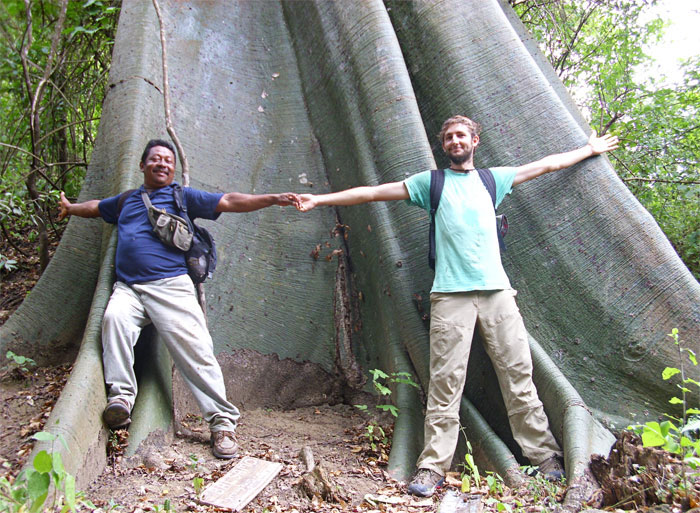



Meanwhile, Orlando has been fearlessly leading the crew working on the revegetation project. Tasks include those at the greenhouse, such as weeding, transplanting trees, composting, cutting bottles, and mixing soil. New seedlings continue to pop up from the seedbeds. We have already amassed hundreds of new saplings for next year’s planting season. In the field, more seeds of Pechiche and Guayaba were collected and sites maintained through macheteing weeds and watering.



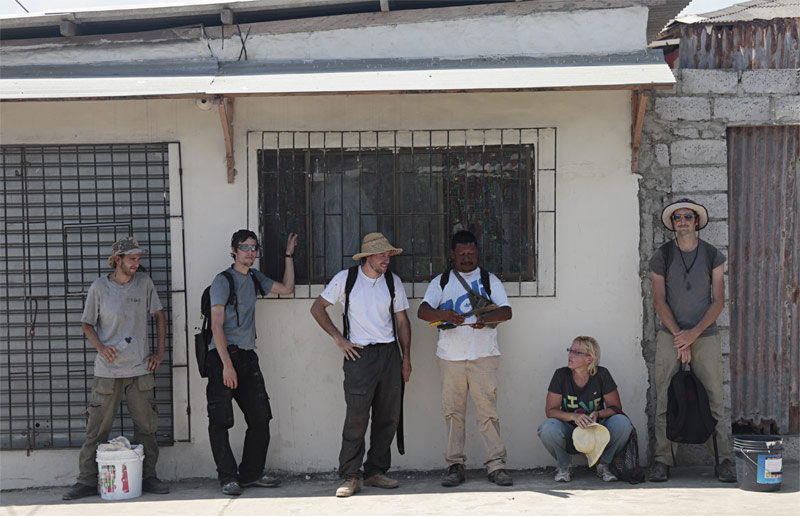

The sites we planted this past rainy season are doing fantastically and the greenhouse is looking excellent. Tree production for next year is on target. We are continuing to look at expanding the selection of native trees that we work with and securing a solid base of native trees that are proven to be good at planting in extremely poor conditions (soil, hillsides, direct sun, very little water, etc).



We also cleaned out the trails and repaired stairs at ‘El Bosque en Medio de las Ruinas’, which had been slightly abandoned. We hope to maintain interest in the park and keep it clean. Some of the neighbors have expressed interest in wanting to plant more fruit trees in the area in the future and have been protecting the forest from anti-socials who have destroyed signs, hand rails, benches and even trees in the past. Without their support, the park could be in much worse shape. After having not planted trees there for the past two years, I am considering taking the locals’ advice to have a tree planting campaign in the area and see with we can’t stir up more support for protecting the park. Although it isn’t surprising, it’s still disappointing that the municipal government has been totally uncooperative in providing any assistance, despite years of asking for it.


The rainy season has definitely wrapped up, pretty anti-climactically. There hasn’t been a solid rain in close to two months. Any precipitation at this point is incredibly unlikely and probably won’t do much to moisten the soil. As a result, we will be watering the revegetation sites from this year as necessary.
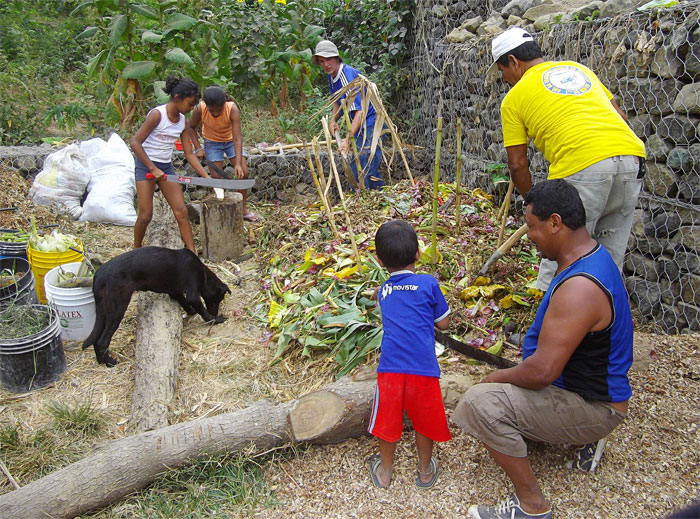
This summer we will be receiving several large groups of volunteers to help with the projects. William and Jaime of Sage Educators in California will be here (again!) for just over two weeks in June with a group of ten people. Children of Ecuador, who have helped fund the Bioregionalismo education program for three years now is returning for the first time since 2008 with a large group for a few days in early July. In late July we will be hosting students participating in an education course offered by the Cloud Forest Institute who are touring ecological projects in various regions of Ecuador.
Despite the influxes of groups of visitors, we still have plenty of space during the summer months for volunteers to come and stay at the Planet Drum apartment, so if you’re interested in participating in our projects it’s not too late! Please visit http://planetdrum.org/volunteerbahia.htm for more information.
Pásalo bien,
Clay
Field Report #5
Clay Plager-Unger
Planet Drum Foundation
May 31-June 27, 2011
June started off with a parade to celebrate international day of the environment. Bahians love to celebrate days dedicated to causes, and they love to parade. It happened to be a great opportunity for the Bioregionalistas to show off their brand new Planet Drum tee-shirts, so we decided to join the festivities. The parade went well, and afterwards, different people had a chance to speak to the group about environmental themes. Some of the Bioregional Education students took the opportunity to share Planet Drum’s message.


Due to a lack of rain probably related to the on set of the dry season, we’ve been watering revegetation sites as necessary. There are three sites this year that need regular watering: Universidad, Dr. Parra, and Jorge Lomas – Don Carlos.

After a week of hard work in the field and at the greenhouse, we took a Friday to visit the Rio Muchacho farm and have a tour of their organic/permaculture activities.

At the greenhouse, two seedbeds exploded with seedlings, one of Chirimoya and the other with Pechiche. These are the two native fruit trees we have had the most success with (in terms of revegetating and donating to communities). They are relatively hardy species as far as fruit trees go and the fruits are quite sought after. It is possible that there are upwards of 800 trees in each of the seedbeds. Needless to say, an abundance of work has sprouted at the greenhouse.

In addition to these two beds, beds of Algarrobo, Jaboncillo, Guachepeli and Seca are also germinating, although a bit more sporadically. The result of all these trees coming up is that we need to transplant them, which is an involved process. Allow me elaborate.
First we collect bottles around town. Many local citizens have gotten used to seeing us wandering around picking up bottles and have decided to help us by separating out their empty bottles from their trash so that we can get a bunch at once, without having to pick through garbage.
After talking to them about the work we do, the end result has often been that we offer to give them trees in December in exchange for bottles now. Now every time we go to collect bottles more and more people are waiting to give us bottles. And more and more will be expecting trees – fortunately those seed beds are looking so good.


Bottles are then transported to the greenhouse, either via truck if there are more than 10 sacks worth (each sack holds about 20), or just on the bus. Once at the greenhouse we cut the tops off the bottles and make holes in the bottom. This can be a daunting task if the pile of bottles resembles a mountain of plastic containers.

While bottles are being cut, other volunteers begin to mix up a pile of soil. Our latest mix of soil contains: 1 bucket of rice shells (hulls), 1 bucket of river sand, 1 bucket of compost (made from our kitchen scraps and saw dust), and 2 buckets of regular dirt (nutrient poor and very high in clay content).

Keeping the proper ratio, this recipe can be scaled up as needed; large batches will call for triple everything. This is kind of like putting together ingredients for a large salad or cake, which would feed a small army. Once the soil is sufficiently mixed and moistened, the bottles are filled. A properly filled bottle should be tamped down so that the soil is compact and approximately one inch (2.5 cm) below the top of the bottle.

As bottle fillers complete the bottles they must be transported to a shady area where they won’t fall over. Shade is needed because direct sunlight will make the transplanting process that much more difficult for the baby trees. Since we’ve been transplanting more trees than ever before, we’ve had to get increasingly creative in making spaces to put the bottles. Pieces of wood make good barriers so that the bottles don’t fall over, and they are secured into the ground with Moyuyo stakes.
Once in a suitable place in the shade, a hole is pushed into the soil with a stick. The depth depends on the tree that we are transplanting, but is usually about 4-6 inches (10-15 cm) deep. Now the bottle is ready for the tree to be planted.

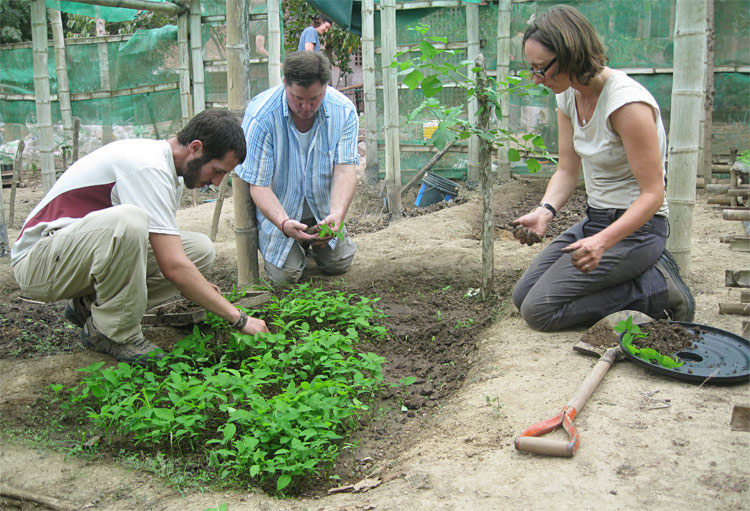
A seedbed that has seedlings ready for transplanting is doused with water so that the soil is soft. The trees are then dug up in batches and moved out to where the bottles are waiting. The roots are kept in moist soil throughout the process. After planting them in bottles and pushing in the soil around the root, water is dripped into the bottle. Occasionally the tree will need some additional soil sprinkled in the bottle to help it stand up straight.


Each transplanted tree requires this entire process to be carefully carried out; otherwise it may suffer and or die. There are currently well over 2,000 transplanted trees in the greenhouse. These trees will grow and be cared for until the upcoming rainy season, when they will hopefully be about 3.3 feet (one meter) tall.
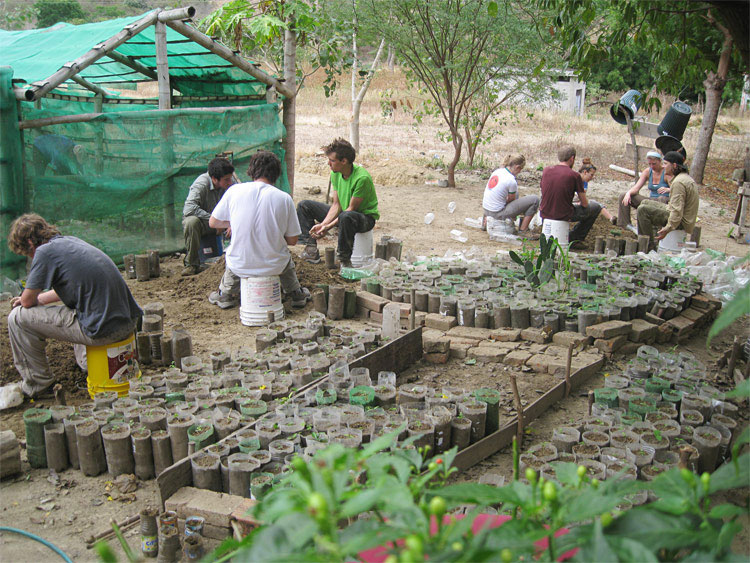
How have we managed to obtain so many transplanted trees in such a small amount of time? With lots and lots of help. In June there have been between five and seven volunteers at any given time. For the last two weeks, a group of ten people from Sage educators in northern California has been volunteering as well. And for the past three weeks, a group of twenty plus Bioregionalismo students have visited the greenhouse to help transplant.
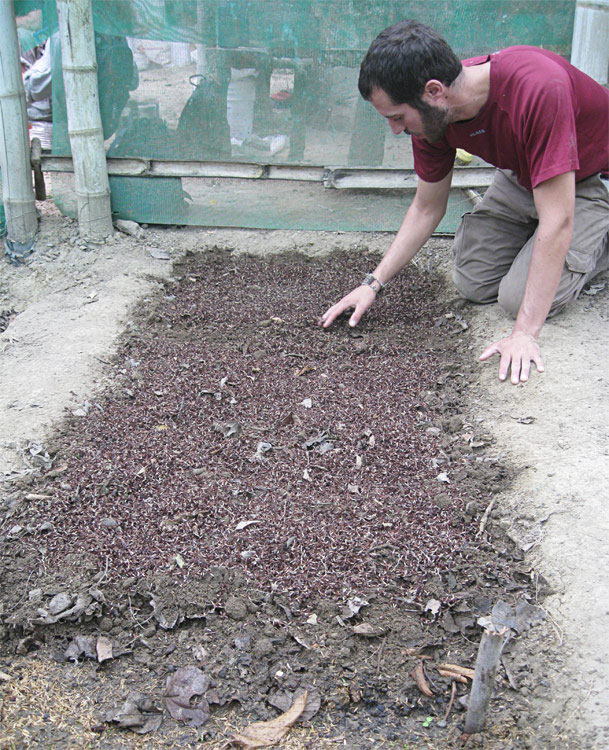
Recently new beds of Algarrobo, Jaboncillo, Laurel and Guayaba have been planted, all of which are showing signs of growing many more trees, which ensures keeping us busy for the coming months. With help from so many people we also prepared more batches of Cascol and Guachepeli seeds to be planted.

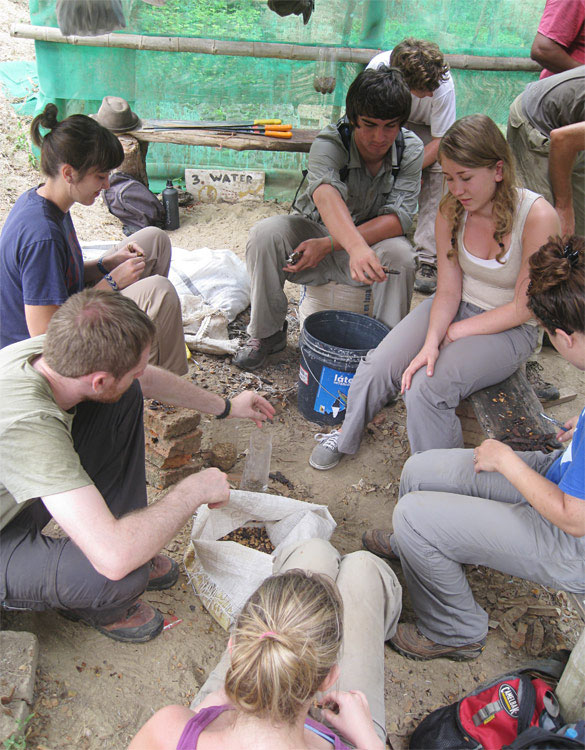
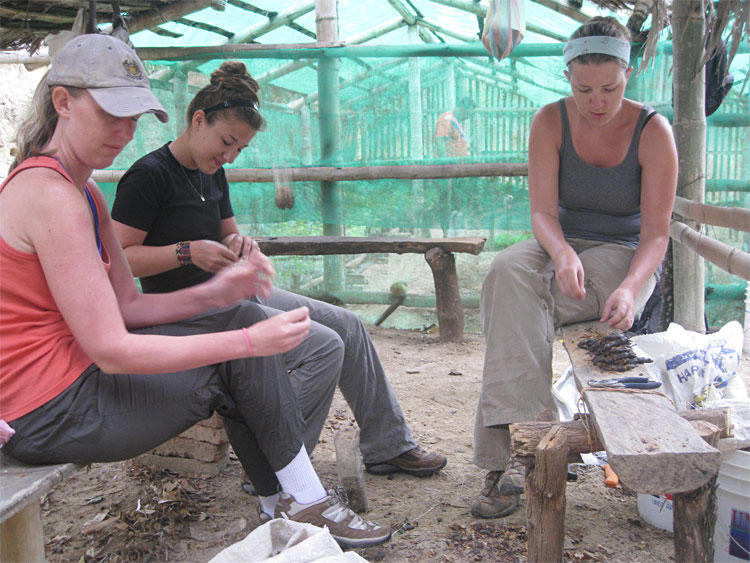


Some minor additions have been made on the greenhouse, including a new bench and a backpack rack. A major overhaul of the break area and the entire greenhouse will need to be made in the not too distance future (at least before the next rainy season).


A day was spent out at our Bioregional Sustainability Institute land, where we worked on opening up a road that will provide access directly to the Planet Drum land from the road. In the near future we hope to have some heavy machinery open up the access road on a steep, partially eroded hill and then we will need to pass a stretch that has been overgrown with shrubs. So between all of us we made a dent in the machete work.

One girl had a minor machete accident, when her machete slipped from her hand and hit her ankle, cutting her. We quickly bandaged the wound and elevated her ankle, which stopped the bleeding. But the wound prevented her from being able to walk, so we also had to fashion a stretcher out of two pieces of Moyuyo branches stuck through two pairs of pants (mine and Chris’s). Taking turns, four people at a time, we carried her for a half an hour and up a small mountain to where our ride picked us up.
We drove her directly to the hospital where they attended to her almost immediately. A few stitches later and she was ready to go home. They didn’t ask for any ID or even charge us anything. A potentially ugly situation was handled without much hassle.

I decided to take advantage of all of the help that we’ve had recently to make a new revegetation site for the 2012 planting season. Revegetation sites require trails to be macheted clear and holes to be dug so that trees can be planted. In May we fixed up the trails in ‘El Bosque en Medio de las Ruinas’ and I noticed that there are a few areas that could really use some more vegetation, particularly in the bottom third of the park. Previously I was under the impression that there wasn’t space there for more trees.


So we began macheting new trails. In two days we opened up enough trails to plant what will hopefully be at least 400 trees (at one tree every 3-4 meters, that’s 1200-1600 meters of trails). It was quite impressive to see 15 people macheting in different directions. And trails were made on an entire hillside in just one day.

As a personal project, Guillaum is working on a book of information about 14 of the native Dry Tropical tree species with which we work. So far we’ve learned that an Algarrobo tap root can reach up to 50 meters in length in order to find water, and their lateral roots can trail up to 60 meters in search of nutrients. Here’s one from El Bosque en medio de las Ruinas that has survived mudslides and soil disruption and continues to grow without any problem.

The final piece of news is that we received a visit from staff members of the Cerro Blanco reserve (near Guayaquil). They have a much larger greenhouse operation there and were visiting projects in the Manabi province. They were impressed by the work we do, even though if it’s on a smaller scale, and they liked our reutilization of plastic soda bottles. We discussed tree planting techniques and different tree species. They even pitched in with some of the work, helping to mix soil and transplant trees.
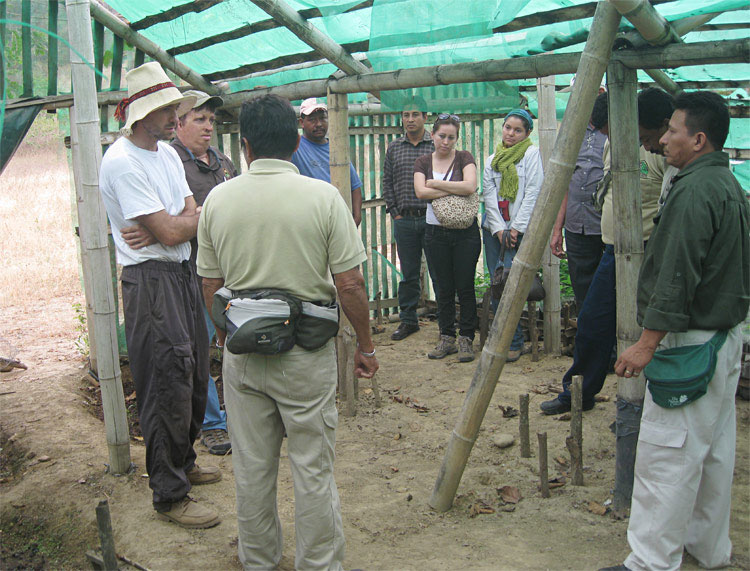
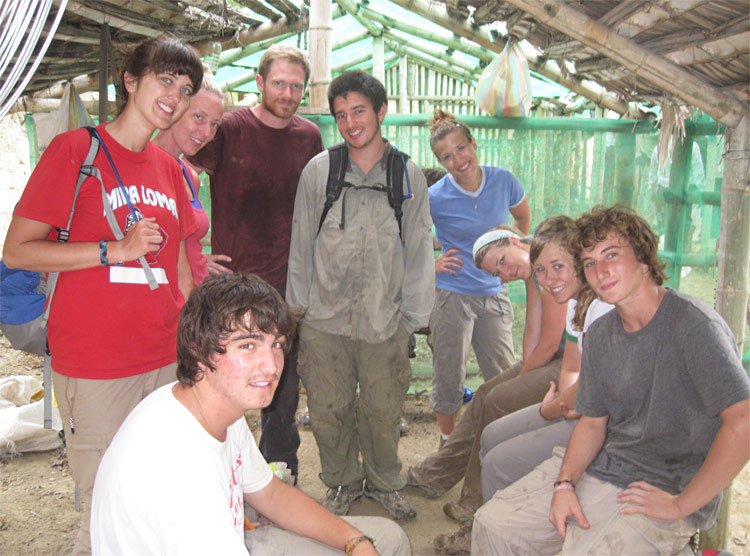
In the near future we will have visits from the Children of Ecuador organization and the Amazon Mycorenewal Project. It’s been great to have so many people helping out with the projects, especially since we have so much work to do. If we keep going anywhere close to this pace, we should easily surpass 5,000 trees at the greenhouse for planting in 2012.
Pásalo bien,
Clay
Field Report #6
Clay Plager-Unger
Planet Drum Foundation
June 28-August 26, 2011


























Pásalo bien,
Clay
Field Report #7
Clay Plager-Unger
Planet Drum Foundation
August 29-October 28, 2011

The past couple of months have been spent focusing on the greenhouse and getting trees ready for planting in the 2012 rainy season. We have surpassed 5,000 trees that will be ready. We have a ton of native fruit trees (Guayaba, Pechiche, and Chirimoya) and lots and lots of other species. Fruit trees tend to be good for donating to the communities and people around town. The others are great for preventing soil erosion because they grow quickly and don’t need much water.




We’ve also made a couple of new additions to the greenhouse. The old ramada with it’s falling down roof was replaced with a new, taller one. It is made out of bamboo and thatch, two of the most sustainable local building materials available. We had some left over thatch from the new ramada, so we decided to buy some more bamboo and make another shade device nearby. These ramadas serve as places to work out of the sun, rest when we need a break, and also as a way to provide shade for recently transplanted trees, which may be sensitive to too much sunlight. Ceibos, for example, are particularly sensitive when they are first transplanted.

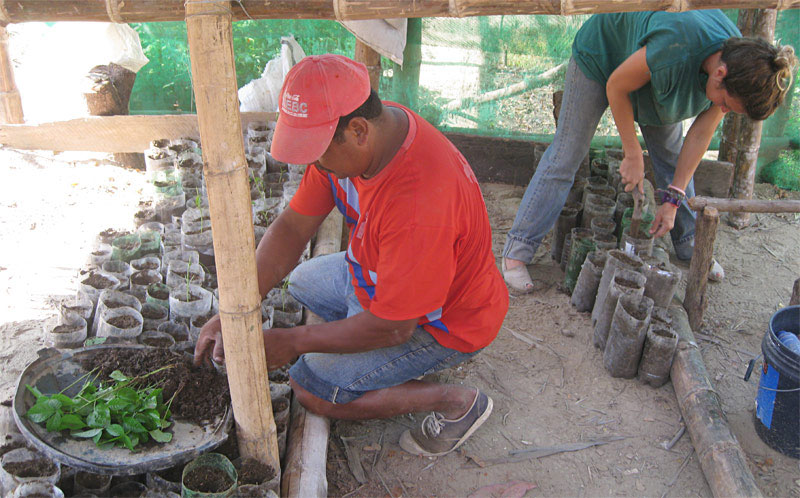
We have also accomplished seed collecting and seed preparation. A couple thousand Guachapeli seeds were collected and removed from their shells for storage until next year. Jaboncillo seeds were also collected in the Astillero barrio.


On a regular basis we go out for a walk to collect bottles. Neighborhood residents are now accustomed to seeing us out looking for bottles and have started helping us by collecting bottles in their houses in sacks. Now when we walk through town we just pick up the sacks and are able to collect a lot more bottles much faster. We have promised to donate baby trees to the households which have helped us collect the bottles. Routinely collecting bottles like this has meant that we no longer need to go out looking for bottles in the trash. Quite the improvement!

In addition to continuing greenhouse maintenance, in the next couple of months we will be talking with landowners about creating new revegetation sites and prepare them for planting. This will involved a lot of macheteing trails and digging holes. If you want to get your hands dirty repairing damaged ecosystems, come volunteer!




Pásalo bien,
Clay
Field Report #8
Clay Plager-Unger
Planet Drum Foundation
October 31-December 19, 2011
The past month and a half has been dedicated to greenhouse maintenance and to watering the trees in bottles that will be transplanted once the rains begin. In the field two new sites have been started, one in El Toro on a piece of government land being used by a local friend who asked us for trees to plant on the hillsides, and the other is a continuation of a site from last year on Doctor Cesar Parra’s land near the greenhouse. Site preparation requires macheteing and hole digging.

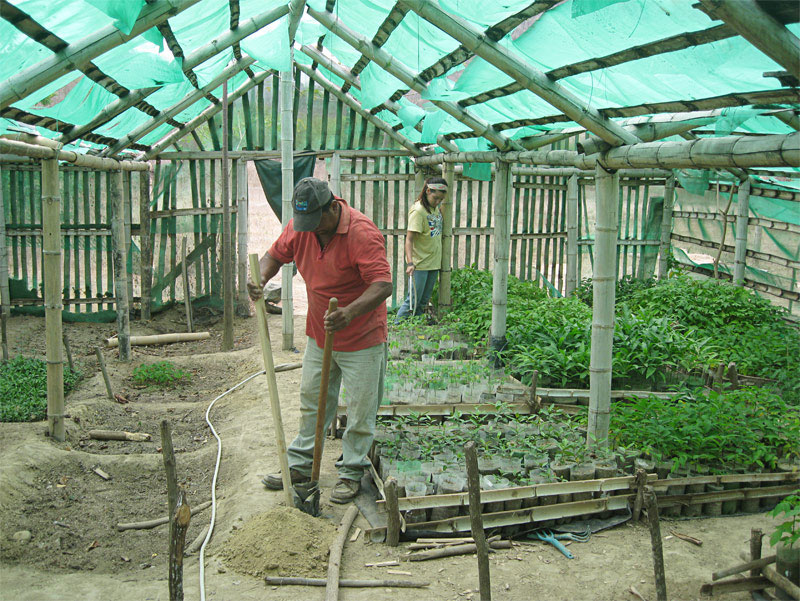

There has been a severe water shortage at the University Catolica, where the greenhouse is located, causing complications and setbacks concerning the availability of water there. Pipes that normally provide a regular source for water have been dry for months. As a result the University has resorted to hiring water trucks to deliver water to their tanks. Scarcity of water around Bahia recently often makes it difficult to even find a truck available for hire.

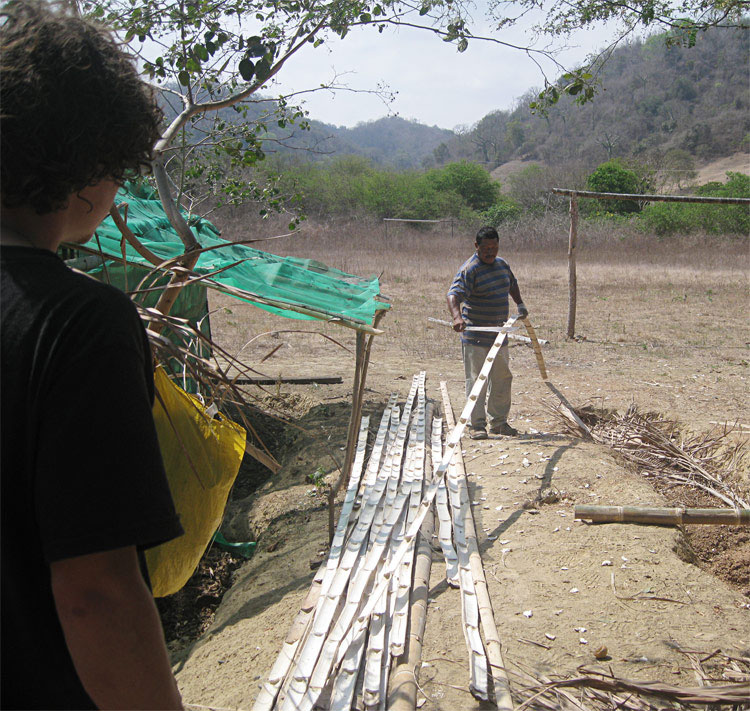

Due to the dangerously low levels of water at the university, on occasion we have been forced to water the trees by hand, with gallon jugs that are normally reserved for watering trees at the revegetation sites. The rest of the time, the water only trickles out of the hose.



Being accustomed to the ways in Bahia, we are used to conserving water. Unfortunately, the crisis at the greenhouse means it takes a lot longer to accomplish the simple task of watering the trees. Also, we haven’t been able to transplant new trees out of the seed beds because of a lack of water for mixing more soil. There are still seed beds of Jaboncillo, Guasmo, Tierramonte, and Guayaba that are ready for transplanting.



Here is an inventory of the trees at the greenhouse that are ready to be planted in the field as soon as possible:
| Algarrobo | 89 |
| Bototillo | 52 |
| Cabo de Hacha | 6 |
| Cascol | 3 |
| Ceibo | 403 |
| Chirimoya | 1,411 |
| Guachepeli | 535 |
| Guayaba | 641 |
| Guayacan | 12 |
| Jaboncillo | 562 |
| Jaile | 249 |
| Pechiche | 955 |
| Seca | 102 |
| Tamarindo | 1 |
| Total | 5,021 |
Of these tree species Chirimoya, Guayaba, and Pechiche are fruit trees. There are 3,007 of these three species, which means well over half of the trees we have this year are fruit producers.
While waiting for the rains to start and the ability to plant trees, we will continue to make progress with new site preparation.
Have a good holiday season.
Pásalo bien,
Clay
